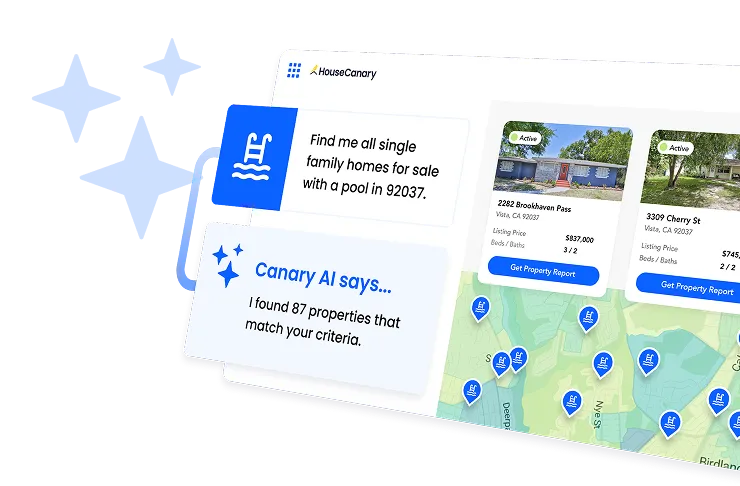
Frequently used in the app:
HouseCanary Value
HouseCanary’s market-leading accuracy in automated home valuations is achieved by streamlining, curating, and merging scattershot real estate data from hundreds of sources, then examining these curated data sets with our proprietary valuation algorithms, using a multistep process that assesses the housing market and dozens more data points to identify which factors have the biggest influence on a home’s value in each market.
Rental Estimate
Our rental estimate uses monthly rent data from all available nearby properties, adjusted for bedroom count, square footage, and other attributes and features that affect rent in this ZIP code. We look at current rental homes in addition to homes that have been used as rentals in the past, examine how those rent prices shift in the context of the local market, and use that information to generate the rental estimate.
Rental Yield
Rental yield is the annual % return you can expect on your rental investment home. It is calculated by dividing the total annual fair-market rent by the purchase price of the home, but unlike cash-on-cash return, it does not include additional operating expenses.
Other useful terms:
ARM — Adjustable-Rate Mortgage
An ARM is a type of mortgage where the interest rate fluctuates over time. The ARM interest rate is periodically adjusted to reflect credit-market activity, so it’s possible for ARM rates to go either up or down, or both, during the lifetime of the loan.
APR — Annual Percentage Rate
An APR is the annual interest rate (calculated as a percentage of the outstanding loan amount) that borrowers must pay on a loan. APRs are used in credit cards, home loans, and many other credit and loan activities.
AVM — Automated Valuation Model
An AVM generates a real estate property valuation by using data, algorithms, and sometimes artificial intelligence to calculate the property’s value. All AVMs compare property information to public record data, and some AVMs use comparable properties (commonly known as “comps”) near the subject property to help calculate the value. The most advanced AVMs use regression models to predict how small differences between properties influence a property’s value.
BPO — Broker Price Opinion
A BPO is an official home sales value opinion outlined by a real estate broker or another qualified real estate professional. BPOs are frequently used in foreclosures, short sales, or other real estate transactions to determine a home’s value without ordering a full appraisal.
CC&R — Covenants, Conditions and Restrictions
CC&Rs are limits or rules placed on homeowners, typically by a homeowner’s association (HOA). CC&Rs must be acknowledged and signed by buyers who want to move into a home in an HOA. Members of the HOA can also contest the CC&Rs in hopes of changing them.
DTI — Debt-To-Income
DTI is a metric that lenders analyze when considering whether to issue a loan to a specific borrower. Usually expressed as a ratio, DTI calculates the total amount of debt that the borrower has against his or her income in order to assess the borrower’s ability to repay a loan.
FEMA — Federal Emergency Management Agency
FEMA was implemented in 1979 as part of the U.S. Department of Homeland Security. FEMA’s primary directive is to coordinate the federal response to natural disasters and emergencies, and it also manages the National Flood Insurance Program (NFIP).
FRM — Fixed-Rate Mortgage
A fixed-rate mortgage is a popular type of home loan wherein the borrower locks in the interest rate at the beginning of the loan and continues to pay back the loan at that interest rate, regardless of inflation or credit-market activity.
FSBO — For Sale By Owner
An FSBO (pronounced “fisbo”) property is a property that’s being sold directly by the owner without the help of a real estate agent.
HELOC — Home Equity Line of Credit
In a HELOC, a lender agrees to extend a line of credit up to a certain amount to a homeowner. The homeowner uses equity in the home as collateral against the loan. Borrowers pay interest on HELOCs, and after the “draw period” during which the borrower can use the line of credit (usually about 5 to 10 years), the borrower must begin repaying the loan in full.
HOA — Homeowners’ Association
HOAs are private associations that dictate standards in specific residential areas. Homeowners are required to pay HOA fees and must sign a contract upon buying the home that says they will abide by HOA guidelines, which can regulate everything from paint color and the appearance of the house to vehicle storage and noise and smell restrictions. The rules established by HOAs are known as Covenants, Conditions and Restrictions (CC&Rs).
HPI — House/Home Price Index
An HPI tracks the change in home price over time in a specific geographic region. It’s one method of telling whether home prices are generally rising or falling. The Federal Housing Finance Agency (FHFA) releases a quarterly HPI, and Case-Shiller and CoreLogic are two for-profit companies that also calculate and track HPI.
LTV — Loan to Value
The LTV is typically expressed as a percentage ratio; it’s a metric that measures the total value of the asset backing the loan (in real estate, a house or another type of residential or commercial property) against the amount of the loan. If a borrower is taking out a loan for more than 80% of the property’s value, then the borrower will likely have to pay mortgage insurance on that loan.
MLS — Multiple Listing Service
The MLS is the local repository for real estate listings and data. In 2011, there were 883 different MLSs in the country, but consolidation by way of mergers has decreased that number. Agents and brokers list homes for sale on the MLS (which is why for-sale homes are also called “listings”), and they can also find homes for sale that might interest their buyer clients on the MLS.
MSA — Metropolitan Statistical Area
MSAs are formally defined metropolitan areas that are established by the U.S. Office of Management and Budget. They group cities and counties using geographic boundaries to help compile apples-to-apples statistical data. They typically consist of one core urban area and its surrounding neighborhoods, towns, and smaller communities, but sometimes they comprise more than one core urban area (San Francisco-Oakland-Hayward and Minneapolis-St. Paul are two examples). There are 382 MSAs in the United States.
NFIP — National Flood Insurance Program
The NFIP gives property owners the ability to secure government-administered flood insurance; in areas that participate in the NFIP, property owners are required to carry flood insurance on their properties. Most of those participation-mandatory communities are in Texas and Florida.
NOO — Non-Owner Occupied
NOO properties are not occupied by the owners. Typically, the owner is instead renting the home, condo, or apartment, either to long-term renters through leases that last several months, or short-term renters through leases that last just a few days or weeks.
NPL — Non-Performing Loans
An NPL describes a loan on which the borrower is not currently paying either interest or principal payments. Local regulations determine when a bank can classify a loan as non-performing and when the loan is considered in default. Typically, a bank or lender will categorize an NPL after 90 days of missed payments.
REO — Real Estate Owned
An REO property is a home owned by a bank, government agency, or government loan insurer. REO properties have been foreclosed but typically did not sell at auction after the foreclosure, so the bank, agency, or insurer that’s now responsible for the mortgage loan retains the property as an asset.
ROI — Return On Investment
ROI helps investors understand what kind of profit or return they are seeing on a particular investment. For example, a rental investor will calculate ROI to get a clear picture of how much money they are spending on investment and how much money they can expect to get back. ROI is typically calculated as a ratio by subtracting the cost of investment from the gain from investment, then dividing the result by the cost of investment.
RTO — Rent To Own
An RTO agreement is similar to a rental agreement, but the potential buyer has the option to purchase the property after an agreed-upon rental period has passed. Potential buyers typically have to fulfill other contract terms, such as paying option money, maintaining the home, or other requirements before the buyer is eligible to purchase the home.
SFR — Single-Family Rental
An SFR is a house that is being rented out instead of occupied by the owner. SFRs can be owned by individual investors with just one or two rentals — colloquially known as landlords — or institutional investors that own thousands of rental homes across the state or country.























